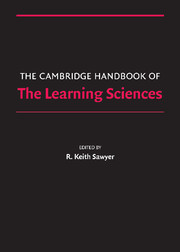Book contents
- Frontmatter
- Contents
- Preface
- Contributors
- 1 Introduction
- PART I FOUNDATIONS
- PART II METHODOLOGIES
- 8 Learner-Centered Design
- 9 The Evolution of Design Studies as Methodology
- 10 Design-Based Research
- 11 Guiding Inquiry-Based Math Learning
- 12 Analyzing Collaborative Discourse
- 13 Assessing for Deep Understanding
- PART III THE NATURE OF KNOWLEDGE
- PART IV MAKING KNOWLEDGE VISIBLE
- PART V LEARNING TOGETHER
- PART VI LEARNING ENVIRONMENTS
- Afterword: After How Comes What
- Epilogue: The Fundamental Issue in the Learning Sciences
- Author Index
- Subject Index
- References
12 - Analyzing Collaborative Discourse
Published online by Cambridge University Press: 05 June 2012
- Frontmatter
- Contents
- Preface
- Contributors
- 1 Introduction
- PART I FOUNDATIONS
- PART II METHODOLOGIES
- 8 Learner-Centered Design
- 9 The Evolution of Design Studies as Methodology
- 10 Design-Based Research
- 11 Guiding Inquiry-Based Math Learning
- 12 Analyzing Collaborative Discourse
- 13 Assessing for Deep Understanding
- PART III THE NATURE OF KNOWLEDGE
- PART IV MAKING KNOWLEDGE VISIBLE
- PART V LEARNING TOGETHER
- PART VI LEARNING ENVIRONMENTS
- Afterword: After How Comes What
- Epilogue: The Fundamental Issue in the Learning Sciences
- Author Index
- Subject Index
- References
Summary
In traditional instruction, the teacher provides information to students, either through lectures or assigned readings. This information typically consists of single-sentence statements of fact, and step-by-step procedures for solving specific kinds of problems. Students are expected to memorize the information and then demonstrate that they've memorized it by doing well on a test – either by restating the facts correctly, or by applying the memorized procedure to solve a problem. This is known as a transmission and acquisition style of teaching and learning. In contrast, learning sciences research emphasizes a new style of learning – one in which the teacher works with students in a community of learners, providing appropriate scaffolds to student project groups as they build knowledge together. In a classroom based on the scientific principles emerging from the learning sciences, students often talk to each other as they construct knowledge together. The teacher is always present but is not dominating the discussion; the teacher often facilitates or channels the discussion, but if students are working together effectively an experienced teacher may realize that the best thing to do is to stay silent.
In emphasizing peer collaboration, the learning sciences is drawing on over twenty years of educational research that has consistently demonstrated that collaboration helps students learn (e.g., Bossert, 1988–1989; Johnson & Johnson, 1992; Kumpulainen & Mutanen, 2000; Slavin, 1990, 1992; Webb & Palincsar, 1996).
- Type
- Chapter
- Information
- The Cambridge Handbook of the Learning Sciences , pp. 187 - 204Publisher: Cambridge University PressPrint publication year: 2005
References
- 10
- Cited by



